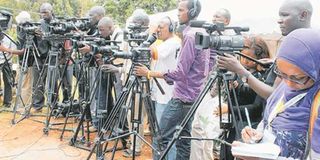How Tanzania media is shying away from politics

Tanzanian journalists at work. A new study has revealed that there was more of media reliance on official calendars for news coverage last year compared to 2017.
Dependence on official calendars increased to 60 per cent in 2018, eight per cent up from 52 per cent recorded in 2017, according to the study.
PHOTO|FILE
Dar es Salaam. Tanzanian media organisations shied away from reporting on politics, and instead diverted more attention to economic and development issues in 2018, according to findings of a new study.
The study on the quality of media in the country shows that politics accounted for only 10.9 per cent of coverage while economic and development issues stood at 28.5 per cent and 27.8 per cent, respectively.
Researchers cited fears by sources to be viewed as too critical of the government as one of the reasons for the interesting trend in media coverage.
Seven key issues were measured during the review dubbed ‘Yearbook on Media Quality in Tanzania 2018’, which was released last week by the Media Council of Tanzania (MCT).
Researchers from Spurk Media Consulting Ltd carried out the study on behalf of MCT.
They compared coverage by media organisations of economic, development, contentious, accidents and crime, culture, media and research issues.
The team reviewed content covered by seven newspapers, five local radio and four television stations, as well as two blogs operating in Tanzania Mainland and Zanzibar.
“Contentious issues accounted for 16.20 per cent, accidents and crime 12.0 per cent, politics 10.9 per cent, culture and media 3.4 per cent and research issues received 1.3 per cent coverage,” said study co-researcher Mr Abdallah Katunzi.
The findings show that newspapers covered more politics, but made an average reporting on economic, development, crime and academic issues.
On the other hand, national radio stations covered less politics, much less than what TV stations broadcasted, but instead aired more of development issues, according to the report.
TV stations had a special bias towards economics, accidents and crime issues.
The findings of the report will not come as a surprise to analysts from various quarters who have over the past two years been worried about the country’s media laws, which they deem restrictive.
Last year, the Media Council of Tanzania and rights activists noted with concern how some provisions of the new media law unfairly restrict what a media outlet can publish.
The 2017 World Press Freedom Index compiled by Reporters Without Borders ranked Tanzania 83 out of 180 countries – a climb down from a ranking of 71 in 2016.
According to the Media Institute of Southern Africa (Misa)’s 2017 overview of the media landscape in Tanzania, freedom of expression, which is guaranteed in the Tanzanian Constitution, “has been undermined by the enactment of the Media Services Act (MSA) 2016, the National Security Act (2016), the Statistics Act (2015), and the Cybercrimes Act (2015), all of which severely curtail media freedoms and access to information.”
Sourcing
Co-researcher Christoph Spurk said the study findings revealed that there was more of media reliance on official calendars for news coverage last year compared to 2017.
Dependence on official calendars increased to 60 per cent in 2018, eight per cent up from 52 per cent recorded in 2017, Mr Spurk said.
According to the report, Michuzi blog recorded 84.6 per cent on dependency on official calendar, while local radio stations’ self-initiated news coverage stood at 48.1 per cent, followed by television stations at 46 per cent and print media 38.5 per cent.
“The print media led in the use of multiple sources (77 per cent), followed by TV stations (68 per cent). Local radio, national radio and Michuzi blog are more or less at the same level of 59 per cent and 62 per cent, respectively,” he said.
Local radio stations also used more female sources (21.9 per cent), followed by television stations (11.9 per cent), national radio (10.9 per cent). Print media fared badly on use of female sources, at 9.8 per cent.
However, print media managed to describe root causes in their coverage (37 per cent), followed by TV (15 per cent).
JamiiForums did well on public debate, exchange of arguments and opinion, but not so well at in-depth analyses of the root cause of issues in the news, reads the report in part.
Furthermore, the report shows that 17 per cent of print media stories consisted of at least two paragraphs of background information, followed by TV stations (13 per cent), local radio stations (8 per cent) and national radio (3 per cent).
“In other words, the media was not seriously engaged in providing adequate background information to stories.”
Regarding different viewpoints, the report shows that JamiiForums led (38 per cent) followed by print media with 32 per cent, local radio 29 per cent, national radio 17 per cent and Michuzi blog hardly any diversity of opinion.
JamiiForums emerged top on the category of stories with opposing viewpoints (27.52 per cent), followed by print media (7.3 per cent), TV (2.9 per cent), local radio (2.8 per cent), national radio (1.8 per cent) and again Michuzi blog trailed with no opposing viewpoints.
“Only JamiiForums shows a considerable amount of critical viewpoint (36 per cent followed by local radio and print with 4 per cent which is rather very low,” reads part of report.
“This can be explained in view of the current political environment in which it is difficult for the media to find sources that openly utter views critical of the government,” reads part of the report.
Mr Katunzi said media houses should develop mechanisms or policies that will increase the ratio of stories originating from media organisation’s initiatives.
“They should improve comprehensiveness, improve the relationship between reporters and editors, increase compliance with editorial rules, think on training initiatives,” he said.




